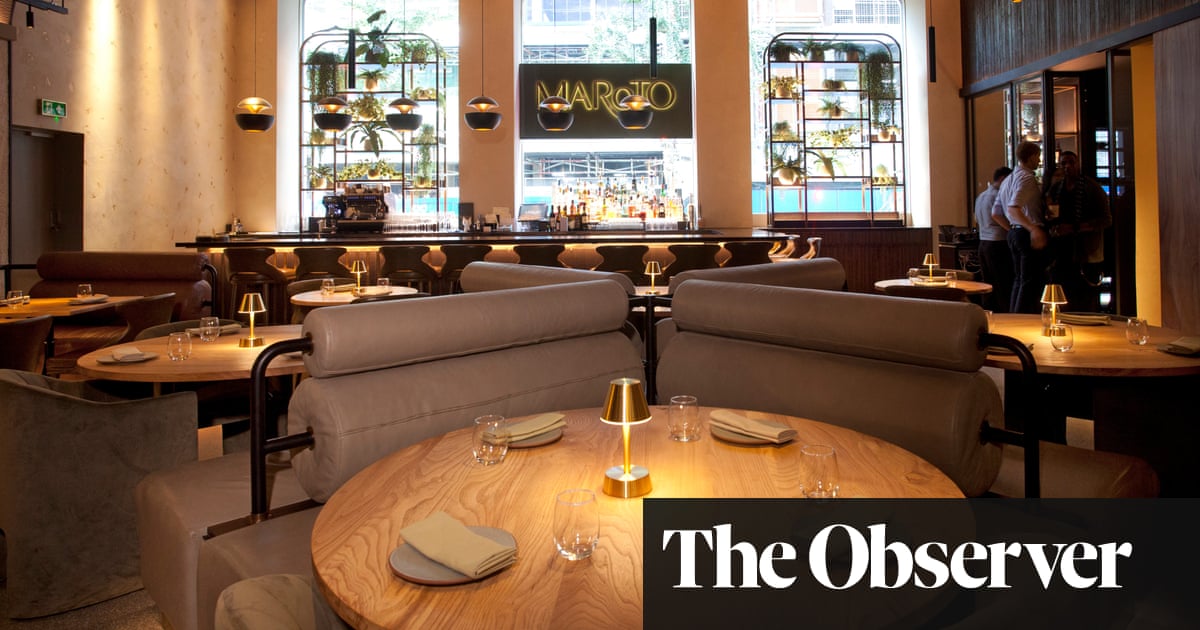Jobs
Maroto, London: ‘I really can’t recommend it’ – restaurant review

Maroto, 4 Vere Street, London W1G 0DH (020 7889 9700). Starters £8-£21, mains £17-£32, sharing dishes £105-£140, desserts £10-£13, wines from £45
Before we get on to the “five flavour experience”, the big selling point of this new Brazilian-inspired restaurant, let’s take a moment to accentuate the positive by admiring the lighting design. Because we do need to find something to celebrate here. The lighting really is a model of its kind. A combination of dangling downlights and strategically positioned lamps on the bare wooden tables means there’s enough illumination to see everything without sparking up the smartphone torch. And yet the rest of the room, with its sandstone-coloured walls and undulating grey leather banquettes, like pilates rollers, is held in a moody, intimate glow. I’d urge restaurant designers to go have a look and take notes. Possibly quite quickly.
Because the problem with that terrific lighting is it also enables you to see everything that’s about to happen to you in acute detail, and it’s not always pretty. Maroto feels like a restaurant conceived in one long brainstorming session, during which everyone got bored and just settled for ideas, which sounded convincing, so they all could go home, regardless of whether they made the slightest bit of sense or not. It’s next to the Brazilian consulate just north of London’s Oxford Street and occupies the space of what was, for less than year, a restaurant called Bossa, from much-decorated Brazilian chef Alberto Landgraf. The new iteration takes the name of the bar underneath that continued trading after Bossa’s closure. Google translate tells me maroto is the Portuguese for naughty, and that’s certainly a word you could use if you were feeling kind. I am not kind.
As well as a few sharing dishes – a whole chicken for £110, a fish for £105 – the heart of the menu is that “five flavour experience”. To quote directly: “Each main dish is accompanied by a unique seasoning representing one of the five flavours. Sweet – Salty – Spicy – Sour – Umami.” This sets off the first alarm bell. “Spicy” is not one of the recognised five flavours. The other one is “bitter”. But I assume that didn’t work with the concept. No worries: at these prices we’ll all end up bitter enough as it is. What you get is a small, plain, well-cooked chicken breast for £19 or three meagre slices of beef for £32, with the same five flavours dotted around both bare, grey plates, like splodges on an artist’s palette. There’s an under-seasoned chilli mayo for the rogue spicy, an acidulated guacamole for sour, soy-marinated mushrooms for umami, a not very salty truffle mayo for salty and what they describe as a “dark marmalade” for sweet.
“But don’t have the marmalade with the meat,” the waiter says quickly, after describing the plate. “It doesn’t go with it.” So why are you serving it? He shrugs. “It is just my opinion.” The opinion seemingly being that the whole damn idea doesn’t really work, does it, but what can you do? None of those flavours makes you think, “Wow, this gives me a whole new perspective on chicken breast.” It just makes you think, wouldn’t it have been nice if the kitchen had bothered to choose the right sauce to go with it?
This weirdness was preceded by a long wait, given there were only nine of us in there, and before that by some dispiriting starters. One was a splodge of refried beans topped by a room-temperature lump of bronzed pork belly that was half cool white fat. Another was described as a hen egg with cep and truffle. There was no sign of either of those, but there was an astringent foaming pond of what tasted like a parmesan cream surrounding an underboiled egg. When you cut in it leaked not just yolk, but sputum-like undercooked white.
Not everything was terrible. Slices of cured sea bass in a bright yellow, citrus-boosted sauce, topped with a pretty flower formed out of ribbons of yellow courgette, was inoffensive. The best dish was a side of rice, mushrooms and beans cooked in a ceramic pot, to which we were invited to add a soy-mirin broth. It was rustic and humble and satisfying. It cost £13. Despite the insistence that this is a Brazilian-inspired restaurant, it felt like the one dish that genuinely engaged with that food culture. I couldn’t help wondering what the staff of the consulate next door make of it all.
Dessert was a brown sugar tart that had a nice enough filling but a soggy, damp pastry shell and a truly appalling chocolate mousse that had been piped into a rose, perhaps a while before, because it had set hard. It tasted mostly of fat. As the waiter cleared these dishes, he made the terrible mistake of asking: “Which is your favourite?” This assumes that one of them definitely is, rather than that you think they should both be put in a burlap sack and dropped in the nearest canal to put them out of our misery. Currently, there is a very short wine list with the cheapest bottle, a Verdejo, at £60. The sommelier told me it would soon be longer and that the entry price would drop to a mere £45. Rejoice!
Some people question the value of angry, negative reviews like this. I was genuinely intrigued by the five flavour thing. If a kitchen could come up with four main courses, all of which paired brilliantly with five different accompaniments – so 20 permutations – that would be an achievement worth writing about. But if, at the end of a £100-a-head meal like this, I conclude it’s a terrible restaurant and I really can’t recommend that anybody should go there, I need to say so. If I had any doubts about this, it was clinched for me by a trip to one of the gender-neutral loos which, at 9.30pm on a Tuesday night when the restaurant was only a quarter full, housed a sanitary and hand towel bin that was full to overflowing. None of the staff seemed to care, so I’m not sure why I should. I’ll post a picture of it to Instagram, because that’s always an aid to the digestion.
Three minutes’ walk away from Maroto on Wigmore Street is a branch of the Lebanese restaurant group Comptoir Libanais, where I happened to grab a quick lunch earlier that day: kofte, salad, rice, some crunchy pickles on the side, and exceedingly good coffee, for £25. Good food. No overwrought concepts. And the bogs are tidy. If you’re in the area and need something to eat, that is one I can recommend.
News bites
Sam and Georgie Pearman, the couple behind the Double Red Duke pub in Bampton, Oxfordshire, which I liked very much when I reviewed it, have opened a new venture nearby. The Mason’s Arms in Clanfield promises ‘Good Guinness and OK wifi’ which seems a reasonable set of priorities, in the right order. Chef Chris Lindsay, who worked with Pierre Koffmann, has come up with a concise menu. The small plates include a rarebit with damsons, a white onion soup and a prawn cocktail, while for mains there’s the likes of roast chicken with onions and bacon, and baked sole with brown crab butter (masonsarmsinn.com).
Chef Michael Caines has announced the closure of his Exmouth seafront businesses Mickeys Beach Bar and Restaurant and the Café Patisserie Glacerie. Both opened in the spring of 2021, but closed on 9 October ahead of a sale to ‘another local business operator who shares a similar passion for fun relaxed dining.’ Caines’s country house hotel, Lympstone Manor, in East Devon, is unaffected by the change.
The Burnt Chef Project, a mental health charity for the hospitality industry, has seen a doubling in the number of its online learning modules undertaken in the past 12 months. Mental health awareness training reached over 2,000 students in 55 catering colleges, while its text-based 24/7 support service was utilised by a little over 3,000 people in 2023, up from about 1,000 people the previous year. For more information on the charity visit theburntchefproject.com.
Join Jay Rayner and Grace Dent on Monday 16 December as they discuss his new cookbook Nights Out At Home, live at Kings Place and livestreamed globally. Book tickets here or at guardian.live
Email Jay at jay.rayner@observer.co.uk or follow him on X @jayrayner1










